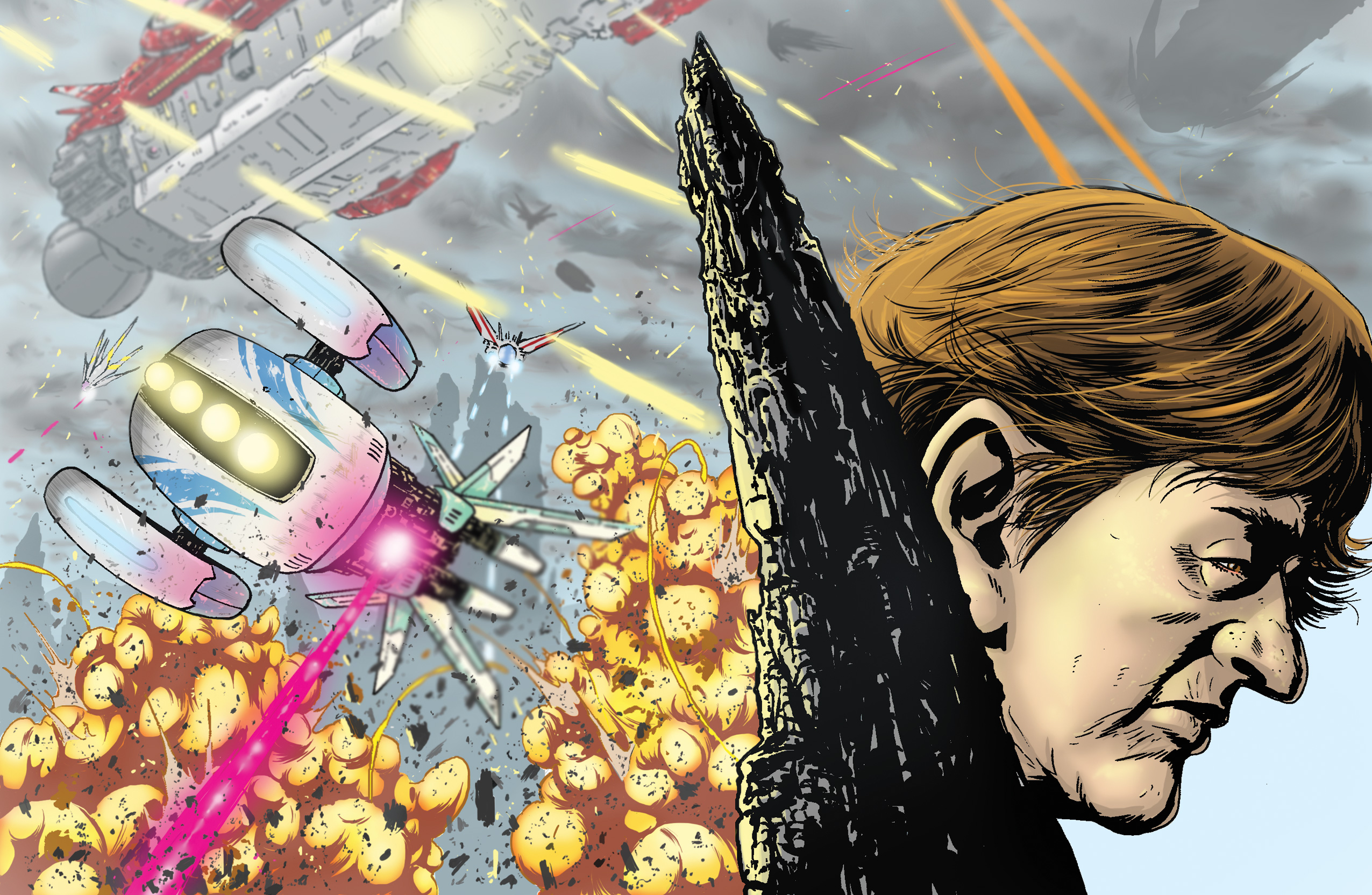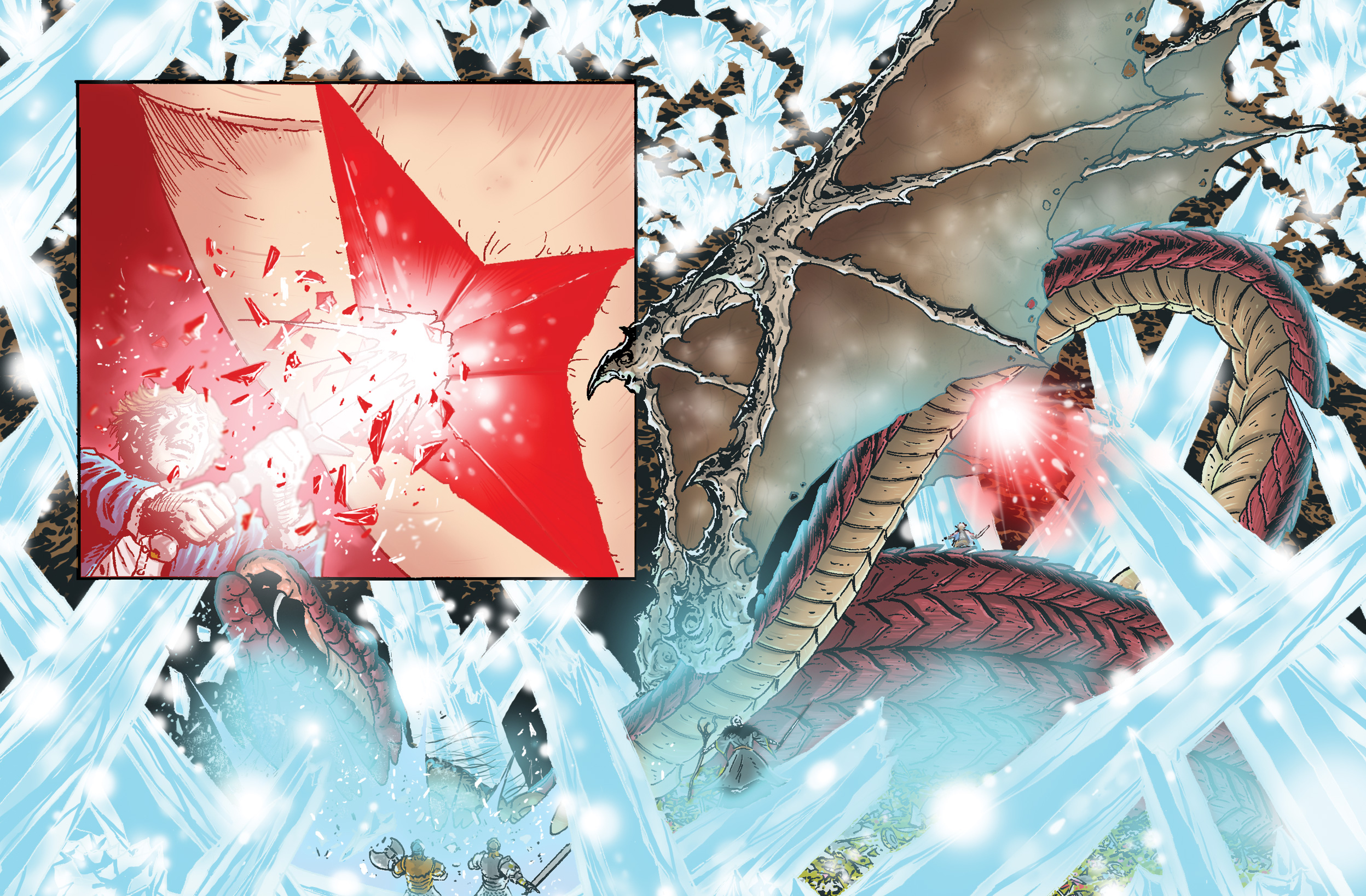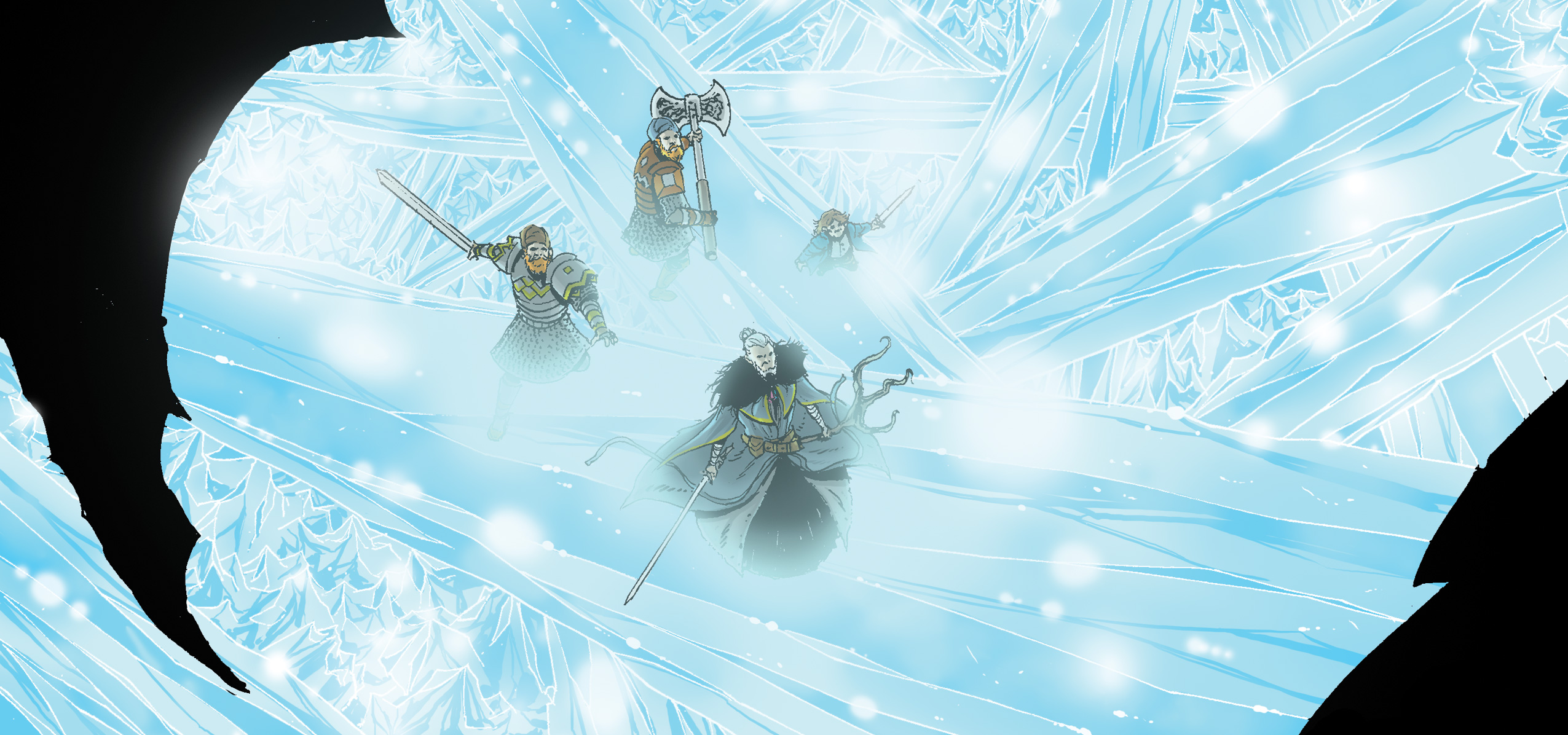The return of KINGMAKER: Ian Edginton & Leigh Gallagher interview
21st March 2019
The magic is back – Kingmaker by Ian Edington and Leigh Gallagher is back in 2000 AD!
In the first series (Progs 2011-2022), readers were introduced to the rich, spectacular fantasy sci-fi world of the Nine Kingdoms, where Edginton and Gallagher take JRR Tolkien, George RR Martin and Orson Scott Card out the back and hit them until they agree to do a sci-fi/fantasy mashup.
Now, with ‘Ouroboros’, beginning in Prog 2123 with a spectacular double episode and stunning Leigh Gallgher cover, we’re returning to the world of Kingmaker!
It’s a dangerous world where the folk of Nine Kingdoms, fresh from overthrowing Ichnar the Wraith King and his Legion of Shadows, now have to live under the rule of The Thorn, an alien race of planet conquerors. With the Thorn Shrike troopers hunting down those with magical abilities, the wizard Ablard now finds himself in the strange company of the Ork Crixus and the dryad princess Yarrow. But will they flee or fight?
We asked series creators, Ian Edginton and Leigh Gallagher, to spill the beans…
In the first series we met Ablard and Crixus, the classic odd couple, forced through circumstance to work together in the face of a shared threat. Can you give new readers an idea of the background to the series?
Ian Edginton: Essentially, it’s aliens invade Middle Earth. The Houses of the Thorn are an intergalactic conglomerate run by a collective of ancient, alien royal families. The most valuable substance to them is known as the Aether or the Quintessence. It’s a form of energy that they use to run everything and even extend their lives. The acquisition of it has become the driving force behind everything they do. There’s much Machiavellian jockeying for power amongst the families but none has had the nerve or resources to go up against the Chairman, until now.
The Aether is usually found locked within the geology of a planet and has to be excavated out, destroying the world in the process. On the world of the Nine Realms though (where our story take place) it manifests as a form of magic. It can be physically wielded by certain of the worlds inhabitants. Duke Eschatus who is overseeing the exploitation of Nine Realms, soon realises that a magic army trained could overthrow the Chairman.
The story opens several years after the House of the Thorn have conquered the Nine Realms and Eschatus secretly trying to get his plan together, capturing magic wielders to either recruit or harvest their powers. There’s a snag however, in the Nine Realms, the Aether (known to the locals as the Ebora or World Spirit) is sentient and has chosen the Ork, Crixus as its agent. Orks are not customarily known for being the good guys and Crixus doesn’t want to be a hero but the world quite literally has decided otherwise. To help him win back the Nine Realms, he’s joined by the aged and whiffy wizard Ablard and the opinionated Dryad Princess Yarrow.
Where will you be taking Kingmaker in this second series?
IE: Crixus, Ablard and Yarrow are endeavoring to find allies but discover that old loyalties have shifted since the invasion and you have to be careful who you trust. Also, Ablard is trying to teach Crixus how to manage his new found powers. Meanwhile, the Duke Eschatus realises that Crixus may well be key to his plans and pulls out all the stops to capture him. We also meet Crixus’s dad.
The series mixes fantasy and sci-fi in a way that 2000 AD has done from early on, Slaine being the best example. In fact, you could, were you so inclined, to shorthand Kingmaker as the sword and sorcery of Sláine without the Conan-like physiques meets good, old-fashioned hard sci-fi. Did you set out with the intention of creating something to mash up the genres in this way?
IE: Absolutely, especially some of the Lord of the Rings type tropes. I wanted to throw them all up in the air and mix them up. There’s no disrespect to the source material (love the books, love the films) but I wanted to kind of do something from an Ork or Trolls perspective. I wanted put forward the notion that because everyone expects them to be nasty and evil, they treat them as such without actually trying to find out first. The rule of thumb seems to be, if you’re ugly, you’re evil and deserve a kicking. In the end they get so pissed off at being treated like shit they react violently which then validates those beating up on them. At one point Crixus says that if you kick a dog long enough it will eventually turn around and bite you, so then the one doing the kicking can say, ‘Look, see. It was a bad dog all long!’
I also wanted to introduce a threat to the Nine Realms that was totally outside of the realm of their experience. Until the Houses of the Thorn invade, they have no clue that there’s life on other worlds. It completely undermines their belief system. The Nine Realms hasn’t been invaded by a Sauron-like, monstrous metaphysical villain who represents a sort of abstract evil. Instead they’ve fallen prey to an efficient, predatory industrial and economic engine. It forces many in the Nine Realms to change their world-view. Heroes become villains and vice versa with many shades of grey in between.
What was your initial desire with Kingmaker, how did it all come about?
IE: All of the above plus I wanted to do something that had a 1970s Heavy Metal magazine vibe. Shades of Moebius and especially Phillippe Drulliet. Massive outlandish looking spaceships, scores of alien races, huge sweeping operatic visuals. Leigh and I had talked about working together for ages. Plus you can always turn an artists head with talk of monsters and spaceships!
Leigh Gallagher: I think Ian and I were at a festival in Lille a few years back. I’ve always wanted to work with that charmer. I was looking for a new series that didn’t involve any historical research as I’d spent a long time doing that on both Defoe and Aquila. I wanted something sci-fi. So he gave me a couple of pitches and I grabbed one of them and said “YES!” Then he told me the rest of the story which involved a feudal society that involved horse and carriages…. and I said “MUTHER FU….NO!!!” So he told about his idea for Kingmaker which I fell in love with.
Leigh, one thing that was instantly obvious in Kingmaker was the lush look to the art, particularly during those incredibly green and gorgeous episodes amongst the Dryads. But, it’s also a strip of contrasts, between that lush green and the barren landscapes under the control of the Thorn, and of the organic shapes of the magical, natural worlds of the Kingdoms and the sharp, technological look of the Thorn. In the first series, you managed to get the balance between intensely kinetic action and worldbuilding just right, delivering a strip that feels balanced and reads beautifully well. How do you go about breaking the beats of the strip down to fit both the five-page serialised nature of 2000 AD and to create a cohesive whole that will work in collected form?
LG: Ian’s pretty descriptive in his scripts with nice bits of reference. In the first book with the first appearance of the massive Thorn ship, he described it as a “refinery with Rococo decoration” so that was a massive help. The Thorn soldiers themselves are a mixture of alien races forced into servitude, so I just go crazy there. With the Kingdom it’s our version of Middle Earth so we don’t deviate too far from what’s established, but at the same time not wanting to repeat what’s out there. We’ve done a good job hopefully making the Dryads different from the Elves. I have a few Lord of The Rings art books to make sure I don’t shamefully rip anything off.
How do you work when putting together Kingmaker?
IE: I send the scripts to Tharg who then sends them to Leigh who then rings me up and weeps down the phone at all the stuff I’ve asked him to draw.
LG: Pretty traditionally to be honest. Me and Ian will have a chat on the phone, he’ll tell me his ideas at 560mph and Tharg will later teleport me the script. When I’m reading it I’ll usually get images sparking in my head of magical creatures, epic battles full of fury and chaos…. then I realise that Ian has laced the pages with a powerful hallucinogen. So I get a cold shower and start again. I do the roughest layouts that only I can decipher, praying to Benedict Cumberbatch that I can get the images in my head to appear exactly the same way on the page. Then I’ll stare at that terrifying white page for the longest time whilst eating cakes. My pencils are pretty loose as I ink myself, but once the inks are done, I scan them into Photoshop and colour on a 19 inch drawing monitor.
It’s a series that looks like it’s a difficult one to put together, with a lot more detail on the page than many strips. Is that right?
LG: Yeah, that’s exactly right! Though that’s all my own doing unfortunately. I seem to be like this on every bloody project, despite me saying that on the next one I’m doing a simpler, easier, quicker style. On Kingmaker in particular, as Tharg very generously allowed me to colour my own interiors this time, I’ve discovered a whole other method to add more detail. I’d rather not spend as many hours doing this stuff than I do, but there’s always been this annoying creature hanging over me, telling me to add lines here, highlights over there….. maybe I’ll find a way to destroy that fecker on my next project….
Also, is there a moment in the scripts where Ian describes the fabulously lush environments of something like the Dryad kingdoms and all you can see is the hours of intense labour he’s just thrown at you?
LG: Yeeeeaaaaaah…… excuse me whilst I just give this creature hanging over me a kick in the balls….
You’re responsible for co-creating several 2000 AD strips, all of which have a very distinct setting/style/look, including Aquila, Defoe, and Kingmaker. Is this something driven by your desire to experiment and change, or by demands of the writer/strip?
LG: It’s true, I’ve made a lot of babies 😉 But yeah, in some cases, I’ve mentioned before it was not wanting to be known as the “historical fantasy guy” in a comic famous for it’s sci-fi. I’m not even a historical fan in real life. So as much as I loved working on both Defoe and Aquila, it’s time consuming looking for the right reference of a historical cod piece, just so I don’t get shouted at by Bob on the internet. (I’m still scarred by my first internet hate mail which said “Leigh Gallagher is full of shit for not doing his research and not drawing the correct breed of buffalo in the buffalo sanctuary!” I was drawing a sex scene taking place at a buffalo sanctuary.) ANYWAY…. it’s just about wanting to scratch itches. Kingmaker with Ian allows me to do that with the awesome sci-fi scenes, and I love having total control over the art now that I’m colouring.
How has your drawing style changes and evolved over the years?
LG: Definitely less cross hatching from my Defoe days. I tortured myself over some of those pages, but I think it’s what you have to do sometimes if it’s a black and white strip. I reigned it in with Aquila and ditched the paint brushes to start using brush pens instead, and with that talented Dylan Teague colouring it looked very different. With Kingmaker, I think my line work is still the same, but with me colouring I can do little things that I couldn’t convey to a separate colourist, like blurring out elements in the foreground.
Do you look back over your old work?
LG: Not much, and if so, only up to a certain time frame. But even after then I’ve definitely screwed certain pages. Some of the later books of Defoe I could still look at with not much wincing, and I’m still pretty made up with how the Carnifex storyline of Aquila turned out. But generally I try to avoid looking back at most of it as obviously I wish I’d drawn it better…..curse of the artist!
What else do we have to look forward to from both of you in the future, both 2000 AD and beyond?
IE: There’s more Scarlet Traces and Brass Sun in the works. D’Israeli and I are also bringing back Stickleback which we’ve wanted to do for ages. There’s more Fiends of the Eastern Front on the cards too.
I’ve also been editing and putting together a collection of prose short stories set in the Scarlet Traces universe. There’s a great line-up with authors such as Stephen Baxter, Adam Roberts, James Lovegrove, Mark Morris, Chris Roberson to name but a few. It’s a lush hardcover that will be coming out from Abaddon later in the year. I’m also writing the next Iron Maiden mini-series for Iron Maiden!
LG: I’ve been so consumed with Kingmaker and a second baby that I’ve not had a chance to nail something solid down. I’ve a couple of possible things in the air once I’ve finished these last episodes, but it’ll be something different until Ian’s ready to jump onto the third Kingmaker series.
Leigh, to end with and seeing as this is the first time we’ve interviewed you here, what were your first 2000 AD experiences as reader?
LG: Prog 546 in 1987 was my first ever prog with that seriously cool and dark John Hinklenton Nemesis cover. Inside was a Freaks strip drawn by John Higgins, who over 30 years later is one of my favourite friends in the business.
The first episode of Kingmaker: Ouroboros is in 2000 AD Prog 2123 – out now in print and digital!





